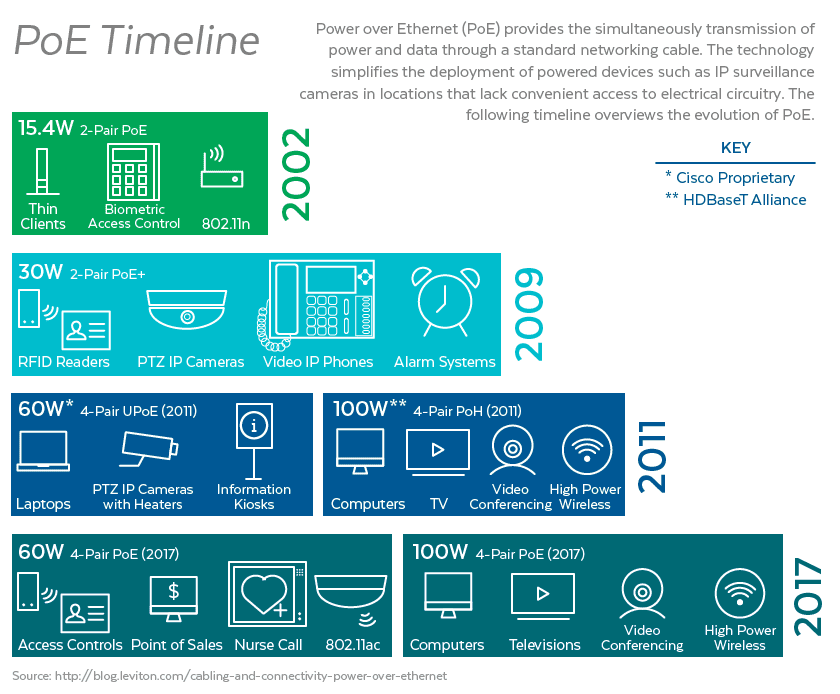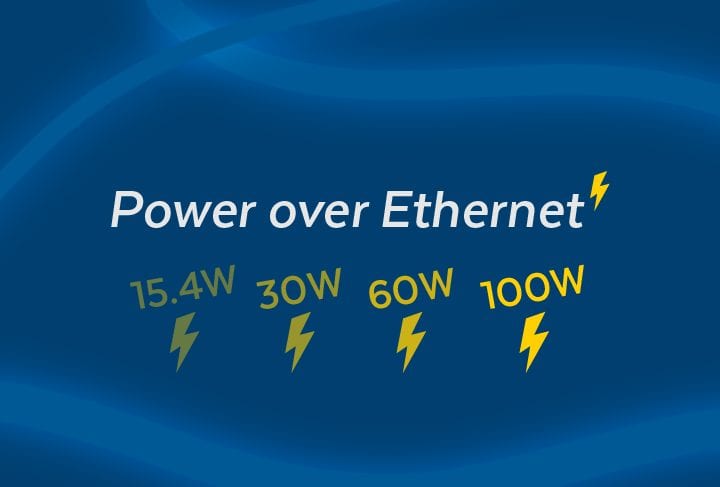Why is Power over Ethernet (PoE) far from reaching market saturation levels?
Power over Ethernet has evolved since its inception in 2002. IEEE has introduced PoE standards with increasingly higher power outputs to account for the evolving use-case scenarios for PoE. But even though the technology has been around for over a decade, PoE has not quite yet achieved market saturation. PoE use-cases are evolving beyond common computer networking applications. Early in its introduction, PoE port growth was driven by VoIP (Voice-over-IP Phones) installations. IP surveillance cameras also contributed to the growth of PoE. As the utility of PoE technology expands beyond common networking applications, Leviton predicts that PoE will experience similar growth rates that were originally seen after its introduction in 2003. A recent Dell Oro presentation confirms the forecast, attributing the growth of PoE port shipments to future PoE lighting installations. Click here to learn more about PoE lighting.
The continuing evolution of PoE use-cases along with IEEE’s standardization of higher power upgrades will continue to fuel the growth of PoE.
What is PoE?
PoE simplifies network installations by delivering both power and data via a standard networking cable. Another factor contributing to PoE’s appeal is cost-effectiveness. PoE remains unencumbered with the strict conduit regulations associated with installing electrical circuitry. PoE allows network installers and system integrators to utilize the same wiring cable to deliver power and data to sites that lack access to electrical outlets. For example, PoE makes it possible to deploy a powered device (PD) such as an IP camera in a warehouse without electrical outlets. With PoE, remote power provisioning becomes as simple as connecting a PoE-capable powered device (PD) to a switch using a standard networking cable.
A Timeline of PoE’s Evolution
The following depicts the evolution of PoE standards since its introduction in 2002.

The Evolution of PoE Standards:
- 2002 marked IEEE’s introduction of the 802.3af standard which specified 15.4W of DC power using 10BASE-T and 100BASE-T. The standard utilized only two of the four twisted pairs in Category 3 Ethernet or higher.
- 2009 marked IEEE’s introduction of 802.3at or PoE+ which specified for 30W of power. The standard also introduced 1000Base-T Gigabit Ethernet over CAT 5 and 6. Similar to 802.3af, the new standard also only utilized two out of the four copper pairs to transmit power. Compliant PoE+ power sourcing equipment features backwards compatibility and can power 802.3af powered devices, as well as devices that require less power than 15 W.
- 2011 saw the emergence of a new high-wattage PoE solution known as Universal Power over Ethernet (UPOE) by Cisco. Cisco’s proprietary technology utilizes four copper cables to transmit 60W of power.
- 2012 introduced Power over HDBaseT (PoH). Even though the standard is capable of delivering 100W of power using all four pairs of Cat5e or Cat6 cable, it is based on the 802.3at standard. HDBASE-T simplifies the connection of television media hubs with its ability to transmit video, audio, power and 100 Mbps Fast Ethernet. The Power over HDBaseT (PoH) was standardized by the HDBaseT Alliance.
- 2013 introduced IEEE’s official study group for 802.3bt, a high-wattage PoE solution that promises to deliver between 60-100W of power. 802.3bt can introduce new use-cases for banking, financial, healthcare, and retail sectors. Official standardization is expected to finalize in 2017.
- 2016 After the official standardization of 802.3bw 100-BASET1 Ethernet for automotive usage, David Law, chair of the IEEE 802.3 Ethernet Working Group, announced the intention to specify a Power over Ethernet (PoE) via automobile Ethernet in the future.
PoE simplifies the deployment of powered devices such as IP surveillance cameras in locations that lack convenient access to electrical circuitry. Click here for a more in-depth overview of PoE.
Want to experience the simplicity of PoE? Click on the link below to overview our PoE equipment.



